Hafod Uchtryd
Hafod Uchtryd (English: summer mansion of Uchtryd) is a wooded and landscaped estate, located in Ceredigion, west Wales, in the Ystwyth valley. It is near Devil's Bridge, Cwmystwyth and Pont-rhyd-y-groes off the B4574 road.[1] It was anciently the location of a dwelling on the side of the hill above the river Ystwyth, looking to the east. First used as a hunting lodge for Welsh Chieftains, it became home to landed gentry and nobility, and in the late eighteenth century became a celebrated landscape, under the ownership of Thomas Johnes.[2]
Hafod Estate
| |
|---|---|
.jpg) A depiction of the Hafod Estate, circa 1795 by John Warwick Smith | |
 Hafod Estate Location within Ceredigion | |
| OS grid reference | SN6676 |
| • Cardiff | 90 mi (140 km)SE |
| Principal area | |
| Ceremonial county | |
| Country | Wales |
| Sovereign state | United Kingdom |
| Post town | ABERYSTWYTH |
| Postcode district | SY23 |
| Dialling code | 01970 |
| Police | Dyfed-Powys |
| Fire | Mid and West Wales |
| Ambulance | Welsh |
| UK Parliament | |
| Senedd Cymru – Welsh Parliament |
|
Early history
The lands of the Hafod Uchtryd were within the boundaries of the Cistercian Abbey Strata Florida (Welsh: Caron-Uwch-Clawdd).
After the dissolution of the monasteries by king Henry VIII (1536–1540) during the English Reformation the abbey's holdings were divided and awarded to new tenants. Some of the Strata Florida lands were granted to the Herbert family, who came to Ceredigion during the reign of Elizabeth I. Sir Richard Herbert of Pengelly and Cwmystwyth was High Sheriff of Cardigan from 22 November 1542.
A rent roll dated 1540 for the granges of Mevenith, Cwmystwyth and Hafodwen (‘newe leases’) reveals that W[illia]m Herbert and Morgan Herbert were tenants of several properties formerly belonging to the Abbey of Strata Florida, including significantly: Havodychdryd Doleygors Pantycrave Bwlch Gwalter parcell of Ty Loge [...] 4 parte of Pwll Piran parte of Pregnant(sic) Prignant Isaf and Blaenmerin and Alltgron. Havodychdryd or Hafod Uchtryd is the name of the house and demesne and the other properties.[3]
The estate became famous in the late 18th century when its owner, Thomas Johnes (1748-1816), developed it as a showpiece of the Picturesque idea of landscape; the estate and the Gothic house were the subject of many descriptions and images produced by contemporary visitors. The history of the estate is the subject of several books, most notably Peacocks in Paradise by Elisabeth Inglis-Jones,[4] and the Hafod Landscape by Jennifer Macve.[5]
The estate lies within the parish of Llanfihangel y Creuddyn. St. Michael (Hafod), Eglwys Newydd, Llanfihangel-y-Creuddyn was a chapel-of-ease in that parish, and was rebuilt for Thomas Johnes by James Wyatt in 1801. It is near Llanddewi-Brefi.
Johnes' Mansion
A new mansion at Hafod was built in 1785 by Johnes, after the demolition of the Herbert structure, from the designs of Thomas Baldwin of Bath in the Gothic style. The library was a spacious, octagonal building within the mansion. Johnes collected many rare and noble books on natural history and manuscripts in Welsh, French and Latin, which also included many by Edward Lhuyd and many manuscripts and printed editions of the French chronicles of the later Middle Ages. The library collection of the Marquis de Pesaro was purchased and housed at the estate.[6] A sculpture by Thomas Banks, representing Thetis dipping Achilles in the river Styx stood in the library; The sculpture was commissioned by his cousin-wife Jane Johnes; the head of Achilles is that of their baby daughter, Mariamne (who lived 1781-1811). This work is currently on display at the Victoria and Albert Museum.[7] Adjoining the library was the conservatory 160 feet (49 m) in length that was filled with a wide variety of rare plants.[8]
Near the entrance from this room into the dining-room hung a painting by Peter Paul Rubens of Decius Mus receiving the Benediction of the Pontifex Maximus. Over the mantel-piece hung a painting of The prophet Elijah fed by the ravens, originally housed at the abbey of Talley, Carmarthenhire, and was, on the dissolution of that establishment, given by the superior to an ancestor of Johnes. Among numerous pictures on display within the mansion were, a portrait of Mr Johnes of Llanvair, by Sir Godfrey Kneller; of Robert Liston, by Wickstead; of Richard Gorges, of Eye, Herefordshire; and of Viganoni; a copy of Guido's Cupid Sleeping, landscapes by Both and Berghem, a painting of the ruined Alchymist by Salvator Rosa. In the drawing-room were, Hogarth's celebrated picture of Southwark Fair, a Descent from the Cross by Van Dyck, an Ecce Homo by Moralez, two landscapes by Claude, a Procession of the Doge of Venice by Canaletti; an Assumption by Bernardo Lonino, pupil of Leonardo da Vinci, which was originally an altar-piece at Lugano; a Holy Family by Rubens, a portrait of Lord Chancellor Thurlow by Gardener, and some beautiful miniatures by Mariamne Johnes. The hall was constructed of Mona marble[9] embellished with a Grecian statue of Dionysus; in addition, six paintings of subjects from Froissart, in imitation of basso relievo, by Stothard.
On 13 March 1807, a fire broke out that completely destroyed the mansion including the contents of the library. Johnes was in London attending Parliament when he heard the news and that his wife and daughter had escaped.[8] The family moved to a rented house in Castle Hill near Aberystwyth. Baldwin of Bath was again hired as architect. On 1 September of the same year, on Johnes's birthday, construction to rebuild the mansion began. Contractors had agreed to pay a heavy financial penalty if the mansion house was not roofed-in by Christmas. Expectant upon moving in Johnes set about replacing the contents of the home. Many of the furnishings were purchased from the Palladian mansion known as Fonthill Splendens, owned by William Thomas Beckford. Interior French glass doors and a number of chimney mantle pieces were purchased, one of which had been sculpted by Banks that featured two couples: Pan and Iris, Penelope and Odysseus. These items were stored at Hafod until the mansion was complete. During construction the family left Castle Hill making tours of London and Scotland, each year returning to find the house unfinished. Construction delays continued until Johnes remained in Wales and made weekly visits, personally overseeing the progress. Altogether the project took three years to complete.
Golden years
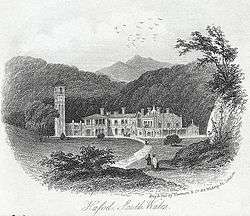
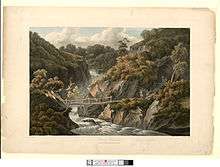
Between 1790 and 1810 were the golden years at Hafod. Between 1782 and 1813 approximately 405 to 485 hectares (1000-1200 acres) of forest, mainly European Larch and Scots Pine were planted on high ground by the estate owner Colonel Thomas Johnes, with oak and beech on the lower, more fertile land. In spite of two months of little rain, of 80,000 larch planted in April 1796, only 200 died. Following a visit to the estate in 1798 by Charles Howard, 11th Duke of Norfolk, the President of the Royal Society of Arts (RSA), Johnes was encouraged to offer himself for the awards made by the Society for silviculture. He was awarded five Gold Medals as follows: [10]
- 1800 - The Gold Medal, being the Premium offered for planting Larch – Trees was this Session adjudged to Thomas Johnes, MP of Hafod.
- 1801 – The Gold Medal, being the Premium offered for sowing, planting, and inclosing Timber-trees, was this Session adjudged to Thomas Johnes, MP of Hafod.
- 1802 - The Gold Medal, being the Premium offered for sowing, planting, and enclosing Timber-trees was this session adjudged to Thomas Johnes, MP of Hafod
- 1805 – The Gold Medal of the Society was this Session adjudged to Thomas Johnes, MP of Hafod, in Cardiganshire, for his plantations of Oaks.
- 1810 - The Gold Medal of the Society was this Session adjudged to Thomas Johnes, MP of Hafod in Cardiganshire, for his Plantations of Larch and other trees.
Approximately three million trees were planted on the estate during the tenancy of Colonel Johnes.
Farm and dairy
New Farm (Welsh: Gelmast), an experimental farm[11] including an extensive dairy was established at Hafod. It was thought that the lands of Hafod and surrounding Cardiganshire were of a type of soil that could not support dairy farming, however in 1800 approximately four tons of cheese and 1,200 pounds (540 kg) of butter were produced. Johnes experimented with varieties of cattle to determine which would produce the most milk. To accomplish these studies, he imported 40 cows from the Netherlands which Johnes referred to has his "Dutch ladies". He was subsequently able to produce Parmesan, Stilton, Cheshire and Gloucestershire cheese at will from his own dairy.[6]
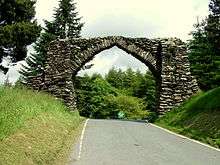
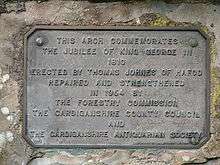
Hafod Arch
In addition to his concern for social welfare of those at Hafod, Johnes actively involved himself in the building of roads and bridges. Upon inheriting the estate there was not one passable road within its boundaries. He built Hafod Arch in 1810 to commemorate George III's golden jubilee.[12] He also built a school for the poor of the community to attend at no charge. A fund was established to assist families hit by casualties. A physician was brought on staff and medicine was supplied. Each year he and Mrs. Johnes opened up their home at Christmas hosting a large event for everyone at Hafod including staff and tenants.[6]
Notable occupants
- John Graham Chambers (1843-1883), sportsman, sports administrator, newspaper editor and deviser of the Marquess of Queensberry Rules of boxing.
Notable neighbours
The estate shares a border along the River Ystwyth with that of the Trawsgoed estate.
Later ownership
- On 13 March 1833 the estate, surrounding structures and land were purchased by the Duke of Newcastle.[6]
- In 1846 the property was sold to Sir Henry de Hoghton, 9th Baronet, Hoghton Tower, Lancashire.[13]
- On 1 June 1857 William Chambers, Esq. acquired Hafod. A £63,000 (and interest) mortgage was secured from Rt. Hon. Baroness Margaret Willoughby de Broke[14]
- 27 April 1871 Lady Willoughby sold the estate to John Waddingham (died 1890).
- From 1890 to 1940 Thomas James Waddingham owned the estate. He adopted Wales and Hafod as his home. He learned Welsh, sat as a JP and was involved in local affairs for the rest of his life. He leased the Myherin Forest area of the Estate to the Forestry Commission in 1929. After he ran out of money, he lived in Aberystwyth from 1932 to his death in 1938, aged 98.[14]
- Between 1940 and 1946 Hafod changed hands three times, and was owned in turn by W. G. Tarrant, T. E. Davies and J. J. Rennie.
Demolition
The mansion was declared vacant in 1946. By 1958 the house was derelict, and it was demolished that year. Only the stables remain, as the current estate offices, and a large pile of rubble. Other isolated buildings and cottages also survive, at least one of which may be rented as holiday accommodation.
Today
Today the Hafod estate occupies some 200 hectares of the Ystwyth valley and surrounding hills. Most is owned by Natural Resources Wales which, in partnership with the Hafod Trust,[14] is managing conservation and restoration projects with public and private funding. In 1998, the Hafod Estate received a grant of £330,000 from the Heritage Lottery Fund. A detailed management plan has been prepared and is now being implemented.
The Estate employs one full-time and two part-time management and administrative staff, a horse logger,[15] and various contract workers, and has recently appointed two crafts-people. Their roles are to ensure that the management plan is carried out to the highest standards.
Visitors today can follow many a waymarked walk that captures the ‘Spirit of Place’ which is Hafod. The Estate is popular with tourists who wish to enjoy some of the most picturesque views and pleasant walks in Wales. The walks have names such as ‘The Gentleman’s Walk’, ‘The Bedford Monument Walk’ and ‘The Alpine Bridge Walk.’ The grassy parkland areas around the ruins of the old house are homes to diverse populations of grassland fungi, notably waxcaps, are represent one of the best areas in the UK for these fungi.[16]
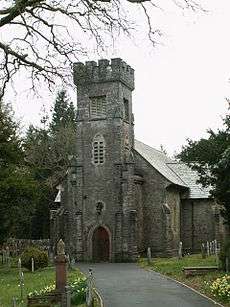 The church is the splendid focal point at Hafod.
The church is the splendid focal point at Hafod. Hawthorn Cottage and pond
Hawthorn Cottage and pond Rubble of the house ruins and remaining wall, with fountain
Rubble of the house ruins and remaining wall, with fountain River Ystwyth in spate at Hafod
River Ystwyth in spate at Hafod Fountain mask
Fountain mask- Cascade Walk
- Waterfall, gentlemans walk
- Wish bone bridge, gentlemans walk
 Upper part of the Peiryan cascade
Upper part of the Peiryan cascade
See also
Further reading
- R. Hallett, 'The 'Hafod' Sketchbook of Thomas Jones', in Welsh Historic Gardens Trust Newsletter; 6 (1992 August)
- R. Hallett et al., 'Scenes from Hafod on Derby Porcelain', in Welsh Historic Gardens Trust Newsletter; 6 (1992 August)
- C. Kerkham, S. Briggs, 'A Review of the Archaeological Potential of the Hafod Landscape', in Ceredigion; 11 (1990)
- G. Cumberland (1996) [1796]. An Attempt to Describe Hafod (reprint ed.). Hafod trust. ISBN 0-9527941-0-1.,[14] includes a map engraved by William Blake and pencil sketches by Thomas Johnes.
- David Yerburgh (2000). An Attempt to Depict Hafod. Hafod trust. ISBN 0-9535635-1-0.,[14] a modern photographic parallel to 'An Attempt to Describe Hafod'
- Borrow, George Henry. Wild Wales: Its People, Language and Scenery. London: John Murray.
- The Annual Biography and Obituary for the Year 1817. London: Longman, Hurst, Rees, Orme, and Brown. 1817.
- Nicholas, Thomas (1872). Annals and Antiquities of the Counties and County Families of Wales. London: Longmans, Green, Reader and Co.
- Inglis-Jones, Elizabeth, Peacocks in Paradise, 1960 ; classic account of the life of Thomas Johnes and of his estate at Hafod
Notes
- PM should head West for a ‘hidden gem’ holiday destination.
- Wild Wales: Its People, Language and Scenery
- The Hafod Collection Archived 2008-09-07 at the Wayback Machine
- Elisabeth Inglis-Jones (1990). Peacocks in Paradise. Gomer press. ISBN 0-86383-672-0.
- Jennifer Macve (2004). The Hafod Landscape. Hafod trust. ISBN 0-9527941-1-X.
- The Annual Biography and Obituary for the Year 1817
- Thetis dipping Achilles into the River Styx 1790
- Oxford Dictionary of National Biography
- Anglesey Serpentine, Mona Marble
- Royal Society of Arts Awards Archived 2008-10-24 at the Wayback Machine
- The Hafod Collection-Complete; Documentation from 1700 to 1940
- Road reopens after damage to arch
- Annals and Antiquities of the Counties and County Families of Wales
- Hafod Estate
- Log Chute Report, Jon West
- Griffith, GW. (2013). "The international conservation importance of Welsh 'waxcap' grasslands" (PDF). Mycosphere. 4 (5): 969–984. doi:10.5943/mycosphere/4/5/10. ISSN 2077-7019.
External links
| Wikimedia Commons has media related to Hafod Uchtryd. |